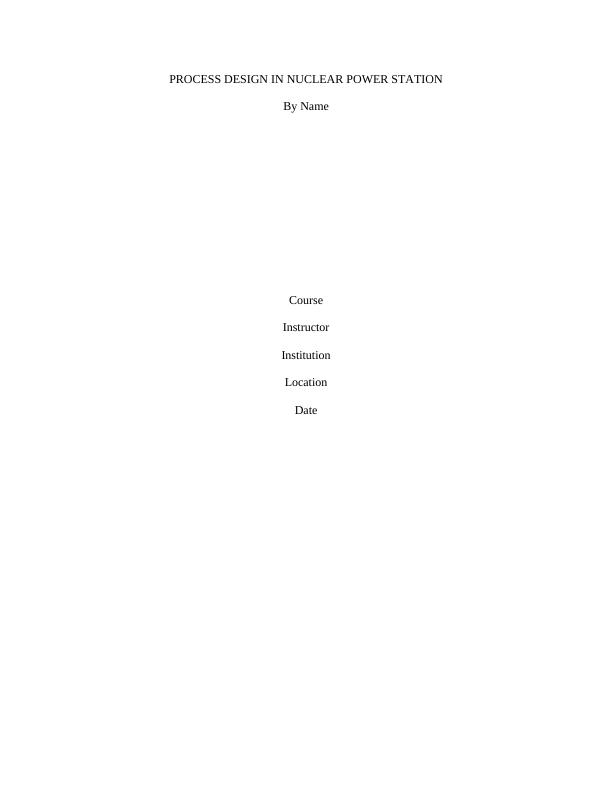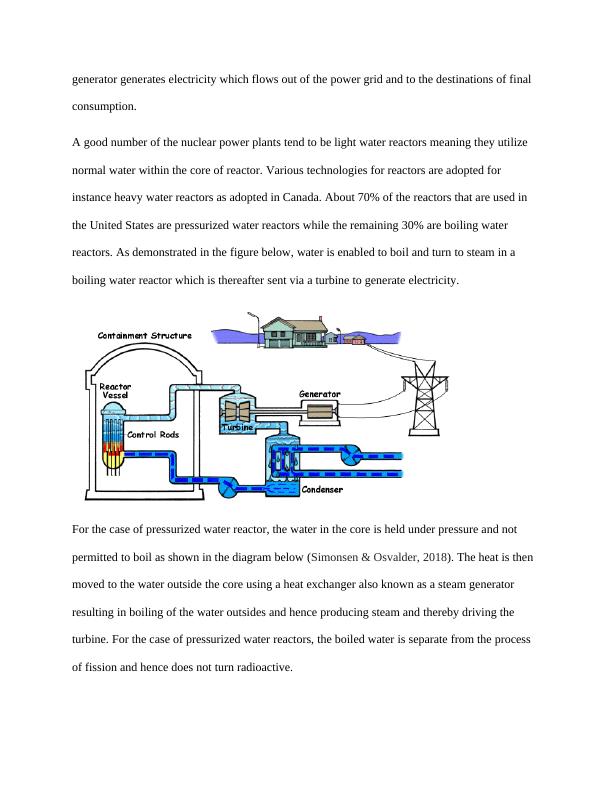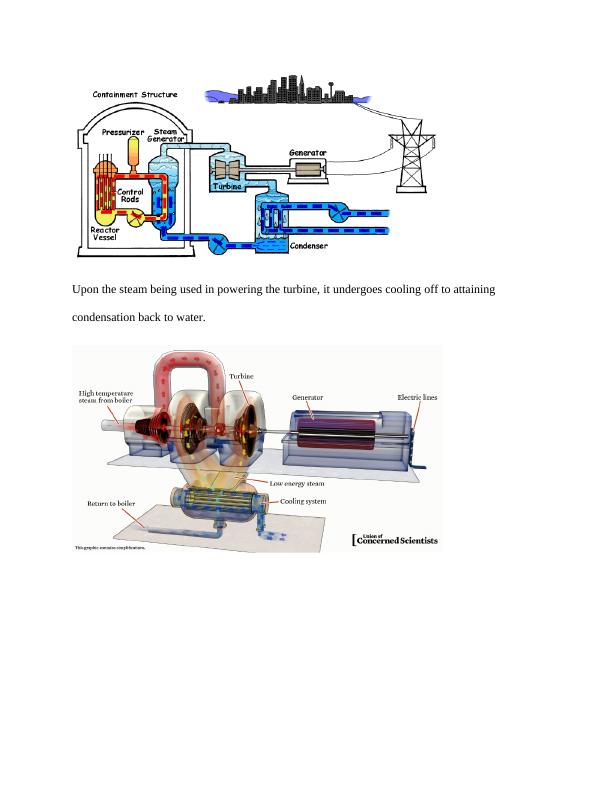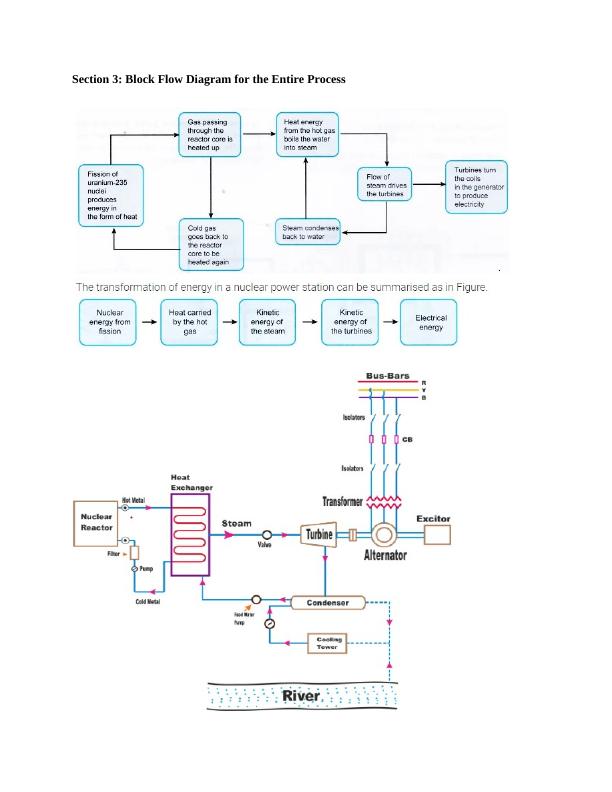Process Design in Nuclear Power Station
Added on 2022-10-06
28 Pages5727 Words496 Views
PROCESS DESIGN IN NUCLEAR POWER STATION
By Name
Course
Instructor
Institution
Location
Date
By Name
Course
Instructor
Institution
Location
Date

Section 1: Introduction
With no production of greenhouse gases during the process of generation, nuclear energy has
gained momentum and popularity as one of the most powerful sources of sustainable energy. In
as much as in most countries among them Germany been making decisions on a phase out of
nuclear, the numbers of nuclear power plants are still on a steady rise all over the world with
about 60 reactors being still undergoing construction in more than 15 countries. Nevertheless,
erecting a nuclear power plant consumes to the tune of billions of dollars and a nuclear power
plant comes along with possible danger to the site. Hence, a nuclear power plant needs quite
sophisticated and careful procedures (Reinerman-Jones, Matthews & Mercado, 2016).
The design of a nuclear power plant should take into account specific features of the site,
operational aspects as well as the plans for future decommissioning in order to attain the highest
standards of safety. An elaborate as well as intense safety assessment is as well a requirement in
ensuring the required protection of the workers, surrounding as well as the public. The design
objective is to offer safe as well as effective working of the nuclear power plant, lowering the
chances of accidents besides ascertaining their effects may be mitigated reliably. The main
means of attaining the same revolves around the defence in depth strategy enshrined in the
implementation of independent as well as consecutive levels of protection. The provisions of
safety of the defence in depth approach with regard to design are among them:
Numerous physical barriers to production of radioactivity
Enough design for the characteristics of the site
Application of firm safety requirements as well as proven practices of engineering to
ascertain enough safety margins
High reliability of the features of design which preserve the integrity of such barriers
With no production of greenhouse gases during the process of generation, nuclear energy has
gained momentum and popularity as one of the most powerful sources of sustainable energy. In
as much as in most countries among them Germany been making decisions on a phase out of
nuclear, the numbers of nuclear power plants are still on a steady rise all over the world with
about 60 reactors being still undergoing construction in more than 15 countries. Nevertheless,
erecting a nuclear power plant consumes to the tune of billions of dollars and a nuclear power
plant comes along with possible danger to the site. Hence, a nuclear power plant needs quite
sophisticated and careful procedures (Reinerman-Jones, Matthews & Mercado, 2016).
The design of a nuclear power plant should take into account specific features of the site,
operational aspects as well as the plans for future decommissioning in order to attain the highest
standards of safety. An elaborate as well as intense safety assessment is as well a requirement in
ensuring the required protection of the workers, surrounding as well as the public. The design
objective is to offer safe as well as effective working of the nuclear power plant, lowering the
chances of accidents besides ascertaining their effects may be mitigated reliably. The main
means of attaining the same revolves around the defence in depth strategy enshrined in the
implementation of independent as well as consecutive levels of protection. The provisions of
safety of the defence in depth approach with regard to design are among them:
Numerous physical barriers to production of radioactivity
Enough design for the characteristics of the site
Application of firm safety requirements as well as proven practices of engineering to
ascertain enough safety margins
High reliability of the features of design which preserve the integrity of such barriers

Section 2: Overall Description of the Process
A nuclear power plant operates more like a conventional power plant even though it generates
heat from atoms as opposed to burning coal, gas, oil or any other fuel. The heat it generates is
used in boiling of water to result in steam that drives one or more of the enormous steam turbines
that are connected to the generators and those generate the electricity which is of specific interest
(Katona, 2019). In the first step, there is loading of uranium fuel into the reactor. The reactor is a
big concrete dome which is reinforced to ensure safety in case of an explosion. In the middle or
center of the reactor which is the core defines the place where the atoms split apart and generate
energy in the form of heat producing neutrons besides splitting other atoms in a precisely
regulated nuclear reaction.
The second step involves raising or lowering the control rods that are made of materials for
instance boron and cadmium into the reactor. This is done to soak up the neutrons as well as
increase or decrease the chain reaction. Pumping of water via the reactor to gather the heat
energy which has been produced by the chain reaction constitutes step three. The water
constantly flows about a closed loop that links the reactor and heat exchanger. Water from the
reactor releases its energy inside the heat exchanger to the cooler water that flows within another
closed looping changing it into steam. The use of two loops of water that are not connected and
the heat exchanger aid in keeping non-contaminated water with radioactivity in safe conditions
in one place and well off from most of equipment used in the plant.
Steam from the heat exchanger is then piped to a turbine and as there is blowing of the steam
beyond the vanes of the turbine, they undergo spinning about at quite high speeds. The spinning
turbine is linked to an electricity generator making it to spin as well (Hugo & Farris, 2016). The
A nuclear power plant operates more like a conventional power plant even though it generates
heat from atoms as opposed to burning coal, gas, oil or any other fuel. The heat it generates is
used in boiling of water to result in steam that drives one or more of the enormous steam turbines
that are connected to the generators and those generate the electricity which is of specific interest
(Katona, 2019). In the first step, there is loading of uranium fuel into the reactor. The reactor is a
big concrete dome which is reinforced to ensure safety in case of an explosion. In the middle or
center of the reactor which is the core defines the place where the atoms split apart and generate
energy in the form of heat producing neutrons besides splitting other atoms in a precisely
regulated nuclear reaction.
The second step involves raising or lowering the control rods that are made of materials for
instance boron and cadmium into the reactor. This is done to soak up the neutrons as well as
increase or decrease the chain reaction. Pumping of water via the reactor to gather the heat
energy which has been produced by the chain reaction constitutes step three. The water
constantly flows about a closed loop that links the reactor and heat exchanger. Water from the
reactor releases its energy inside the heat exchanger to the cooler water that flows within another
closed looping changing it into steam. The use of two loops of water that are not connected and
the heat exchanger aid in keeping non-contaminated water with radioactivity in safe conditions
in one place and well off from most of equipment used in the plant.
Steam from the heat exchanger is then piped to a turbine and as there is blowing of the steam
beyond the vanes of the turbine, they undergo spinning about at quite high speeds. The spinning
turbine is linked to an electricity generator making it to spin as well (Hugo & Farris, 2016). The

generator generates electricity which flows out of the power grid and to the destinations of final
consumption.
A good number of the nuclear power plants tend to be light water reactors meaning they utilize
normal water within the core of reactor. Various technologies for reactors are adopted for
instance heavy water reactors as adopted in Canada. About 70% of the reactors that are used in
the United States are pressurized water reactors while the remaining 30% are boiling water
reactors. As demonstrated in the figure below, water is enabled to boil and turn to steam in a
boiling water reactor which is thereafter sent via a turbine to generate electricity.
For the case of pressurized water reactor, the water in the core is held under pressure and not
permitted to boil as shown in the diagram below (Simonsen & Osvalder, 2018). The heat is then
moved to the water outside the core using a heat exchanger also known as a steam generator
resulting in boiling of the water outsides and hence producing steam and thereby driving the
turbine. For the case of pressurized water reactors, the boiled water is separate from the process
of fission and hence does not turn radioactive.
consumption.
A good number of the nuclear power plants tend to be light water reactors meaning they utilize
normal water within the core of reactor. Various technologies for reactors are adopted for
instance heavy water reactors as adopted in Canada. About 70% of the reactors that are used in
the United States are pressurized water reactors while the remaining 30% are boiling water
reactors. As demonstrated in the figure below, water is enabled to boil and turn to steam in a
boiling water reactor which is thereafter sent via a turbine to generate electricity.
For the case of pressurized water reactor, the water in the core is held under pressure and not
permitted to boil as shown in the diagram below (Simonsen & Osvalder, 2018). The heat is then
moved to the water outside the core using a heat exchanger also known as a steam generator
resulting in boiling of the water outsides and hence producing steam and thereby driving the
turbine. For the case of pressurized water reactors, the boiled water is separate from the process
of fission and hence does not turn radioactive.

Upon the steam being used in powering the turbine, it undergoes cooling off to attaining
condensation back to water.
condensation back to water.

Section 3: Block Flow Diagram for the Entire Process

End of preview
Want to access all the pages? Upload your documents or become a member.
Related Documents
Two Most Efficient and Environmentally Friendly Non-renewable Energy Sources Research Paper 2022lg...
|6
|1555
|14
Advantages and Disadvantages of Nuclear Energylg...
|10
|1993
|341
Nuclear Fission in The United States of Americalg...
|18
|6177
|43
The Nuclear Power Development in The United Stateslg...
|19
|5921
|149
Concentrated Solar Power: Current State, Impact, and Technological Developmentslg...
|19
|4534
|472
